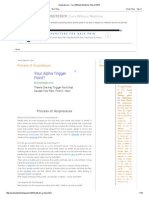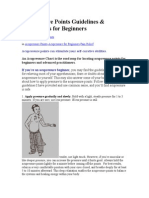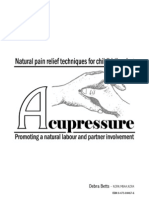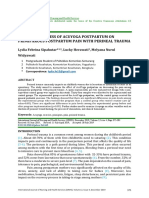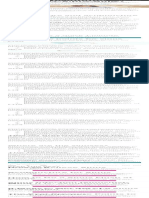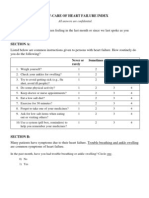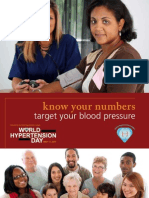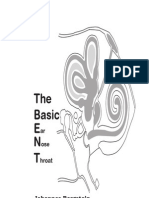Acupressure
Acupressure
Uploaded by
Indra YaniCopyright:
Available Formats
Acupressure
Acupressure
Uploaded by
Indra YaniOriginal Description:
Copyright
Available Formats
Share this document
Did you find this document useful?
Is this content inappropriate?
Copyright:
Available Formats
Acupressure
Acupressure
Uploaded by
Indra YaniCopyright:
Available Formats
Acupressure is a natural method of healing, achieved by pressing various specific points in our body.
It
requires no medicines and has no bad side effects.
Acupressure :
Cure Without Medicine
Home
Monday, April 29, 2013
Introduction to the Acupressure Points : (32-35)
Introduction to the
Acupressure Points :
(Point No. 32 Energy - Point No. 35 Eyes)
Point No. 32 Energy :
Download Android Apps
Blog Archive
Blog Archive
Acupressur
e (6) Pineal
gland (3) Pituitary
gland (3) Solar
Plexus (3) Pain
point (2)
Reflexology (2)
Sinus (2)
Categories
34 Cold (1)
Acupressure Point (1)
Acupressure t reat ment
(1) Acupunct ure (1)
Allergy (1) Breast
point s. (1) Cure (1)
Diagnosis (1) Diseases
(1) Heart (1) Illness (1)
Inst rument s of
Acupressure (1) Kidney
(1) Medicine (1) Neck
(1) Nervous syst em (1)
Ovary (1) Painful (1)
Piles (1) Point s (1)
Pressure point (1)
Prost at e gland (1)
Sciat ic nerves (1) Self
Diagnosis (1) Sexual
Organs (1) Shoulder (1)
Spine (1) Test is. (1)
The Brain (1) Therapy
(1) Throat (1) Thyroid
and Parat hyroid Gland
(1) Toxins (1)
Treat ment (1) Ut erus
(1) Vagina and Penis
(1) Vit al Force (1) rules
of Acupressure (1)
Share 3
More
Next Blog Create Blog
Sign In
Some common problems :
* Tiredness
* Insomnia
* Lethargy
On the hands we should use only our fingers but on our feet we can use either.
Point No. 33 Nerves of the Ear :
Some common problems :
* Impaired hearing
* Tinnitus
* Ear infection
* Earache
On the hands we should use only our fingers but on our feet we can use either.
Point No. 34 Cold :
Some common problems :
* Headaches
* Sneezing
* Coryza
* Cough
On the hands we should use only our fingers but on our feet we can use either.
Point No. 35 Eyes :
Acupressure point no 32, Energy.
Acupressure point no 33, Nerves of the Ear.
Acupressure point no 34, Cold.
Posted by milon siddique at 2:45 AM 1 comment:
Labels: 33 Nerves of the Ear, 34 Cold, 35 Eyes, Energy
Some common problems :
* Lachrymation
* Dry eyes
* Burning
* Cataract
* Eye infection
* Eye diseases
* Vision problems e.g. myopia etc.
On the hands we should use only our fingers but on our feet we can use either.
Source : A Self Treatment Manual by Sagar Sagir.
Acupressure point no 34, Eyes.
+9 Recommend this on Google
Saturday, April 27, 2013
Introduction to the Acupressure Points : (28-31)
Introduction to the
Acupressure Points :
(Point No. 28 Adrenals - Point No. 31 Ears)
Point No. 28 Adrenals :
Females have larger adrenals than males. It is a hormonal gland situated above the kidneys. It
controls the fire/heat in the body.
When it isn't functioning properly it can effect the spleen, liver and gall bladder. It controls the
body's minerals and metabolises water. It helps turn calcium into fat. It activates our muscles and
helps coagulate blood.
It makes the spleen increase our red blood corpuscles. It aids the beginning of sexual
development in children. Its good functioning creates people of high moral character and inner
strength.
Some common problems :
* Indigestion
* High blood pressure
* Low urine pressure
* Lack of heat in the body
* Excessive fat
* Lack of mental development
* Lack of sexual power
Acupressure point no 28, Adrenal.
* Lethargy
* Infertility
* Vomiting
* Headaches
* Greed, pride, anti-social activities
* Lack of concentration
* Excessive urination
* Heartburn
* Reflux
On the hands we can use either our fingers or an instrument but on our feet we should use
only the instrument.
Point No. 29 Solar Plexus :
This point needs to be checked regularly because lifting heavy weights and excessive gas can
displace it.
Some common problems when displaced :
* Constipation
* Dehydration
* Dysentery
In females, it can cause pain in the chest and the lower abdomen. If it is displaced for a long
time, digestion could be permanently impaired.
On the hands we should only use our fingers and on our feet we should only use the
instrument.
Point No. 30 Lungs :
Some common problems :
* Throat pain
* Tonsillitis
* Goitre
* Diphtheria
* Cough
* Voice problems
* Whooping cough
* Throat infection
* Hemoptysis
* Bronchitis
* Chest pain
Acupressure point no 29, Solar Plexus.
Acupressure point no 30, Lungs.
Posted by milon siddique at 10:19 PM 1 comment:
Labels: Adrenals, Ears, Lungs, Solar Plexus
* Asthma
* Emphysema
* Pain on the sides of the chest
On the hands we can use either our fingers or an instrument but on our feet we should use
only an instrument.
Point No 31 Ears :
Some common problems :
* Impaired hearing
* Tinnitus
* Ear infection
* Earache
On the hands we should only use our fingers but on our feet we should only use an
instrument.
Source : A Self Treatment Manual by Sagar Sagir.
Acupressure point no 31, Ears.
+7 Recommend this on Google
Friday, April 26, 2013
Introduction to the Acupressure Points : (24-27)
Introduction to the
Acupressure Points :
(Point No. 24 Shoulder - Point No. 27 Stomach)
Point No. 24 Shoulder :
Some common problems :
* Pain
* Cramps
* Frozen shoulder
* Joint problems
This point should only be pressed using an instrument. Point No. 25 Pancreas :
Acupressure point no 24. Shoulder.
This gland creates insulin. If the pancreas produces less insulin than it should, the result is usually
diabetes.
If the pancreas overworks and creates too much insulin then the results are :
* Headaches
* Migraines
* Low blood pressure
* Addiction to sweet things
* Lethargy
* Alcohol dependency
On the hands we can use either our fingers or an instrument but on our feet we should use
only the instrument.
Point No. 26 Kidney :
Cleans 175 liters of blood every day. It sends waste to the bladder.
It controls blood pressure and water in the body. It controls sodium chloride and creates Vitamin
D.
Some common problems :
* Burning on passing urine
* Strong smell
* Colour too yellow
* Infections
In the hands we can use either our fingers or an instrument but on our feet we should use
only the instrument.
Point No. 27 Stomach :
Digests and stores food. With the help of hydrochloric acid, it digests protein and fat. Water,
Acupressure point no 24. Pancreas.
Acupressure point no 26. Kidney.
Acupressure point no 27. Stomach.
Posted by milon siddique at 6:55 AM 1 comment:
Labels: Acupressure, Kidney, Pancreas, Shoulder, Stomach
glucose, alcohol and medicines go directly into the blood stream.
Some common problems :
* Stomach pain
* Headache
* Vomiting
* Giddiness
* Feeling bloated
* Bad smell in the mouth
* Inability to taste food
* Loss of appetite
* Constipation
* Diarrhoea
* Heaviness in the stomach
* Coating on the tongue
* Lack of saliva
Problems can arise from not chewing food properly or enough, excessive spice and/or oil in the
food, eating too frequently, smoking, drinking tea, coffee and alcohol, stress, frustration, infection
and the toxic effects of medication.
On the hands we can use either our fingers or an instrument but on our feet we should use
only the instrument.
Source : A Self Treatment Manual by Sagar Sagir.
+7 Recommend this on Google
Wednesday, April 24, 2013
Introduction to the Acupressure Points : (20 - 23)
Introduction to the
Acupressure Points :
(Point No. 20 Colon - Point No. 23 Liver)
Point No. 20 Colon :
The large intestine. In stores the body's waste.
Problems may result in :
* Constipation
* Piles
* Abdominal pain
This point should only be pressed using an instrument.
Point No. 21 Appendix :
Acupressure point no 20. Colon.
Situated on the right side of the body.
No important function.
Main problem is appendicitis which may result from eating too much and/or too fast as well as
constipation.
Symptoms of appendicitis :
* Right-sided abdominal pain
* Vomiting
* Nausea
* Constipation
* Diarrhoea
This point should only be pressed using an instrument.
Point No. 22 Gall bladder :
Its function is to make and store bile. It helps to digest fats and to facilitate in stool evacuation. It
helps to activate the adrenals and the pancreas.
Some common problems :
* Right- sided hack pain from the shoulder down to the abdomen
* Vomiting
* Pain in the abdomen
* Cold sweat
* Burping
* Loss of consciousness.
This point should only be pressed using an instrument.
Point No. 23 Liver :
Waste from food is passed to the liver. Also bile is created there. Fats, vitamins and iron are
stored in the liver which is passed to the rest of the body when needed. It creates and controls
heat.
Problems which may occur :
Acupressure point no 21, Appendix.
Acupressure point no 22, Gall bladder.
Acupressure point no 23, Liver.
Posted by milon siddique at 7:50 AM No comments:
Labels: Appendix, Colon, Gall bladder, Liver
* Excessive acidity
* Heat and gas may be produced
* Burning sensation in the stomach
* Teeth and gum problems
* Ulcers in the mouth and stomach
* Eye problems
* Vomiting
* Hair and skin problems
* Quick to anger
* Jaundice
* Water retention
* Stomach pain
* Feeling queasy
* Sense of weakness
Good foods for liver problems :
* Coconut water
* Sugar cane
* Oranges
* Glucose
* Potatoes
* Raw papaya
* Soft rice
* Small fish
* Half a lemon squeezed in water for 17- 21 days to be taken after meals, once a day.
* Avoid lifting and/or carrying heavy things.
* Avoid spicy food, chillies
* Avoid the sun and heat.
This point should only be pressed using an instrument.
Source : A Self Treatment Manual by Sagar Sagir.
+7 Recommend this on Google
Monday, April 22, 2013
Introduction to the Acuressure Points : (16 - 19)
Introduction to the
Acupressure Points :
(Point No. 16 Lymph glands - Point No. 19 Small Intestine)
Point No. 16 Lymph glands :
This gland defends the body from disease by the creation of bio- toxins and helps cure infections
when they occur.
Some common problems :
* Infections
* Cancers
Acupressure point no 16. Lymph glands.
* Diabeties
If it functions well we would never get cancer or diabetes.
On the hands this point needs to be pressed with the hands slightly upturned.
In the hands we should only the fingers but on our feet we can use an instrument if we
wish.
Point No. 17 Hip and Knee :
Problems :
* Muscle and joint pain.
This point can be done with either an instrument or the fingers.
Point No. 18 The Bladder
it works with the kidney to rid the body of toxins and waste products. Its job is to store urine and
pass it out at intervals.
Some common problems :
* Polyuria (passing to much urine)
* Oliguria (passing to little urine)
* Yellow urine
* A weak flow of urine
* Incontinence
* Burning sensation on passing urine
This point can be done with either an instrument or the fingers.
Point No. 19 Small Intestine :
One of the places where food is processed and digested.
Acupressure point no 17. Hip and Knee.
Acupressure point no 18. The Bladder
Acupressure Point No. 19 Small Intestine.
Posted by milon siddique at 4:40 AM No comments:
Labels: Hip and Knee, Lymph glands, Small Intestine., The Bladder
Some common problems :
* Gastric problems
* Diarrhea
* Abdominal pain
* Dehydration
* The creation of uric acid which can result in gout.
On the hands we can use our fingers or an instrument but on our feet we should use only
an instrument.
Source : A Self Treatment Manual by Sagar Sagir.
+10 Recommend this on Google
Saturday, April 20, 2013
Introduction to the Acupressure Points : (12-15)
Introduction to the
Acupressure Points :
(Point No. 12 Vagina and Penis - Point No. 15 Testis)
Point No. 12 Vagina and Penis :
Some common problems :
* Impotence
* Pain during sex
* Sexual problems
This point should only be done using the fingers.
Point No. 13 Uterus :
Some common problems :
* Irregular, excessive or scanty periods
* Uterus may get displaced with heavy physical work
* Uterine prolapse
* Leucorrhoea
* Dysmenorrhoea
* Fibroids
This point should only be done using the fingers.
Acupressure point no 12. Vagina and Penis
Acupressure point no 13. Uterus.
Posted by milon siddique at 11:47 PM No comments:
Labels: Ovary, Testis., Uterus, Vagina and Penis
Point No. 14 Ovary :
This is a sexual gland, it creates the hormones oestrogen and progesterone. Its proper functioning
enables pregnancy to be carried to full term.
Some common problems :
* Abortion
* Tumours
* Infertility
This point should only be done using the fingers.
Point No. 15 Testis :
It creates sperm and sexual hormones.
Problems may lead to :
* Infertility
* Discharge
* Sexual problems
This point should only be done using the fingers.
Source : A Self Treatment Manual by Sagar Sagir.
Acupressure point no. 14 Ovary.
Acupressure point no. 15 Testis.
+9 Recommend this on Google
Thursday, April 18, 2013
Introduction to the Acupressure Points (8 -11)
Introduction to the
Acupressure Points :
(Point No. 8 Thyroid and Parathyroid - Point No. 11)
Acupressure Point No. 8 Thyroid and Parathyroid :
This gland is situated in our windpipe and produces thy-Roxine. It has a huge sphere of control.
* It plays an important role in child development
* It helps us absorb calcium
* Helps with excretion of waste and toxins
* Maintains body temperature
* Develops good mental qualities e.g. concentration, good behavior, generosity, love, self- control
* It helps with the good functioning of the kidneys and the muscles
Some common problems :
* Osteoporosis
* Lack of bone development resulting in bulky, short stature
* Overweight
* Rough and/or thick skin
* Loss of mental strength
* Anemia
* Stones form in the kidneys
* Diminished sexual potency
* Reduced calcium absorption leads to weakened bones and muscles
* The muscles may be affected by fine tremors
* Increased appetite
* Passing urine too frequently
* Increased heartbeat
* Quick to anger and over emotional
* In adults, the formation of kidney stones
* Fat deposits in the neck and midriff
This point can be done with either an instrument or the fingers.
Acupressure Point No. 9 Spine :
Problems may arise as a result of the lack of flow of bio-electricity e.g. a bad cold may result in
lessening bio-electricity in the spine which may create pain around the heart, leading people to
think they may have heart problems.
Also spinal problems could result in speech difficulties. Other problems which may occur are
back pain, including that in the lower back.
This point should only be done using the fingers.
Acupressure Point No. 10 Piles :
Acupressure point no 8. Thyroid and Parathyroid
Acupressure point no 9. Spine.
Posted by milon siddique at 11:30 PM No comments:
Labels: Piles, Prostate gland, Spine, Thyroid and Parathyroid
This results when the vein in the rectum becomes engorged with blood and may lead to bleeding,
severe discomfort and pain.
In severe cases, a permanent pile may be present externally or internally. Piles occur because of
possible underlying liver problems, chronic constipation, diarrhea, smoking, alcohol, and too much
fat, chilli or spice in the diet.
Sometimes the vein in the rectum can become infected. Piles can lead to a weakened heart and
can also affect the prostate gland.
There may be headaches and also loss of blood which, in severe cases, could lead to anemia.
This point can be done with either an instrument or with the fingers.
Acupressure Point No. 11 Prostate gland :
In childhood this gland is inactive. At puberty it starts working and around the age of 50 it starts
slowing down.
If the gland becomes enlarged or infected, passing urine becomes difficult.
Also women need to press this point because it prevents urinary infections and other
urinary and kidney problems.
This point should only be done using the fingers.
Source : A Self Treatment Manual by Sagar Sagir.
Acupressure point no 10. Piles.
Acupressure point no 11. Prostate gland.
+6 Recommend this on Google
Tuesday, April 16, 2013
Introduction to the Acupressure Points (4-7)
Introduction to the
Acupressure Points :
( Point no. 4, Pineal gland - Point no. 7, Neck)
Acupressure Point No. 4 Pineal gland :
The health and secretions of the other glands is dependent on the healthy functioning of this
gland. It controls the sodium and potassium balance in the body.
If this gland is in good health, humans can reach great heights of inner peace and kindness and
great powers of self-control in regard to pain and sorrow.
Some common problems :
* High blood pressure
* Sexual problems
* Water retention in the limbs which is often mistaken as kidney disease
This point can be done with either an instrument or with the fingers.
Acupressure Point No. 5 Head blood vessels :
These provide the connection between the brain and the body.
During headaches and migraines these dilate and give rise to throbbing pain.
This point should be done only with the fingers.
There are 2 parts of the throat :
* Larynx and trachea
* Pharynx and esophagus
This point should be done only with the fingers.
Acupressure points 4, Pineal gland
Acupressure Point 5. Head blood vessels
Acupressure Point No. 6 Throat :
Acupressure points 6, Throat.
Acupressure Point No. 7 Neck :
Posted by milon siddique at 11:52 PM No comments:
Labels: Head blood vessels, Neck, Pineal gland, Throat
Some common problems :
* Neck pain
* Stiff neck
* Tension.
This point should be done only with the fingers.
Source : A Self Treatment Manual by Sagar Sagir.
Acupressure points 7, Neck.
+6 Recommend this on Google
Sunday, April 14, 2013
Introduction to the Acupressure Points (Sinus-3)
Introduction to the
Acupressure Points :
(Sinus-Point 3 Pituitary gland)
These points are located at the tips of the fingers and toes.
This point should be done with an instrument.
A most important point which houses our knowledge and wisdom. It is full of nerves which
facilitate the flow of bio-electricity. This bio-electricity creates energy and controls the physical
processes of the body.
It also controls the emotions and the sub-conscious.
Some common problems :
* Headaches
* Migraine
* Giddiness
This point should be done with an instrument.
Acupressure point: Sinus
Sinus point
Acupressure Point No.1 The Brain :
Brain point.
Acupressure Point No. 2 Cranial nerves :
Posted by milon siddique at 4:58 AM No comments:
Labels: Cranial nerves, Pituitary gland, Sinus, The Brain
All the information processed by our brain is carried by our nerves. These form an extremely
complex network and are responsible for conveying all commands to and from the brain.
The left brain controls the right side of the body and vice versa.
Some common problems :
If around our nerves, there is not enough circulation of blood or oxygen, we may feel
chronically stressed. If these connections become very weak, our organs may be
affected adversely.
This point can be done using either an instrument or the fingers.
This is located in the brain and is considered the control centre of all the endocrine glands. It is
responsible for our judgement, our wants, and gives our mind its direction.
If this gland works perfectly then the person may be highly creative and skilled in whatever
activities are conducted.
Some common problems :
* Obesity
* Children may be very naughty and/or dishonest
* After childbirth, it may be difficult for the mother to lose weight.
* Pregnancy with this condition may result in a brain damaged child.
* Adults may have a bad memory
* Sexual potency may be reduced.
* Rough skin and skin lesions.
* There may be hormonal deficiencies in men.
" Mental development may be retarded.
* In taller men there may be spinal defects.
This point can be done with either an instrument or with the fingers.
Source : A Self Treatment Manual by Sagar Sagir.
Cranial nerves point.
Acupressure Point No. 3 Pituitary gland :
Pituitary gland point.
+6 Recommend this on Google
Saturday, April 13, 2013
Acupressure Point Description.
Acupressure Points
on the Feet and Hands.
* Sinuses
01. Brain
02. Cranial nerves
03. Pituitary gland
04. Pineal gland
05. Head blood vessels
06. Throat
07. Neck
08. Thyroid & Parathyroid
09. Spine
10. Piles
11. Prostate gland
12. Vagina & Penis
13. Uterus
14. Ovary
15. Testis
16. Lymph glands
17. Hip & Knee
18. Bladder
19. Small Intestine
20. Colon
21. Appendix
22. Gall bladder
23. Liver
24. Shoulder
25. Pancreas
26. Kidney
27. Stomach
28. Adrenal
29. Solar Plexus
30. Lungs
31. Ear
32. Energy
33. Nerves of the Ear
34. Cold
35. Eye
36. Heart
37. Spleen
38. Thymus
* Breast point
* Points of the Nervous system
* Sciatica points
* Points of the Middle finger
* Allergy point
Source : A Self Treatment Manual by Sagar Sagir.
Acupressure Points.
Posted by milon siddique at 5:32 AM No comments:
Labels: Acupressure, Points.
+6 Recommend this on Google
Friday, April 12, 2013
The rules of Acupressure (part-5)
The rules of
Acupressure (part-5)
Which points do we need to press before we finally finish?
The point that must be pressed last is no. 26, the kidney point. When doing acupressure we
release the toxins that have accumulated in various organs and glands and the elimination of
these is helped by pressing the kidney point last.
How can I tell if I am getting better ?
If, by doing acupressure regularly the pain in my points improve then I am getting better and this
will also become apparent in the symptoms I had before starting the treatment.
Why is the pain during acupressure worse on the feet than on the hands ?
Our feet are more sensitive then our hands because our hands are in constant us and may be
desensitized.
How can I stay youthful?
Our bio- electricity is created in the finger- tips of our right hand. The central point is midway
between our wrist and our elbow. This point is called the main switch and is a round point an inch
across. If, this point is pressed daily, then the aging process is slower.
How many days does it take to cure a disease ?
In for instance, painful joints such as the neck or the shoulder we may get relief very quickly
although to cure the problem completely will take longer. Generally the longer we have had the
problem the longer it may take to cure it. Also we need to take notice of the way we eat and live,
to help the curative process.
What are the instruments used in Acupressure ?
Generally we can use our Fingers and/or a blunt such as the rounded end of an unsharpened
pencil.
The important thing to remember is that it doesn't matter what we use so long as we find the
correct location of our pressure points by being aware of the pain, tenderness or sensitivity in the
point being pressed. Always do it the way it feels correct to you. You may prefer to use your
index finger rather than your thumb on certain points, it really doesn't matter.
Posted by milon siddique at 6:11 AM No comments:
Labels: Instruments of Acupressure, rules of Acupressure
Source : A Self Treatment Manual by Sagar Sagir.
+5 Recommend this on Google
Wednesday, April 10, 2013
The rules of Acupressure (part-4)
The rules of
Acupressure (part-4)
What is priority therapy ?
If the patient has many problems we have to deal with the most important 2 or 3 first along with
their supporting points. When these are better, then, we can start to focus on the less urgent
problems.
What is the process of effective therapy ?
It is very important to find the precise pain point in the pressure points that hurt. The size of each
pressure point varies e.g. the spine point is 2 inches long whereas the kidney point is the size of a
finger tip. Because of these differences one has to feel around for the P.P and press it twice as
much as the area around it.
Is it possible to do acupressure whilst walking, sitting or talking ?
Yes, hand points are easy to do at any time and usually one will get some benefit from doing
them when one is not fully engaged in the process. But, when one can, it is best to do it with full
concentration.
Which fingers do we use for this therapy ?
Usually when we press we use the thumb and for support we use the middle and index fingers.
For some points we may need to use all our fingers.
What should we use when pressing children's points ?
For children under the age of 8 we should only use our fingers. Over the age of 8 we can use an
instrument unless any of the points are very sensitive in which case we should only use the
fingers. On point 19 on the feet we should use an instrument.
Can we do acupressure on children while they sleep ?
Yes, we can but not to the extent that we disturb their sleep.
In elderly patients or those with very sensitive points, what should we use ?
We should use only the fingers. On the feet only points 19, 20, 22, 23, 25, 27, 28, 29, 36 and 37
should be done using an instrument, At all times the pressure should be gentle.
How do you use the thumb when pressing the points ?
The thumb can be used in 4 ways: -
1) The tip of the thumb can be used as a pointer and for this we need to keep our nails short.
2) The flat of the thumb using the top joint.
3) The knuckle of the thumb is useful when trying to find the P.P.
4) The side of the thumb when we need to apply a lot of pressure on the points which have
bones.
In children how do we use our thumb ?
The tip of our thumb can be used for all the points in a child's hand. But, for points 2, 5, 8, 11-16,
19, 29, and 31- 35 in both the hands and feet, the flat of the thumb should be used.
The knuckle can be used for points 1, 3 and 4. Also points 5, 7, 8, 9, 10, 11, 16, 17, 18, 19, 20, 24,
and 31- 37 can all be pressed using the knuckle.
Posted by milon siddique at 12:36 AM No comments:
Labels: Pain point, Therapy, Thumb
Source : A Self Treatment Manual by Sagar Sagir.
+9 Recommend this on Google
Monday, April 8, 2013
The rules of Acupressure (part-3)
The rules of
Acupressure (part-3)
Does the pain point change its location ?
People`s pain point is individua1 to them and is not always in exactly the same area of the point.
Also pain points can change location within the point when one starts acupressure.
Can one pressure point have more than one pain point ?
In our experience we have found that this is rare but if there is more than one pain point then
both should be pressed. Generally we find more than one P.P. in points 8, 9, sciatica points, and
the points of the nervous systems.
What are the rules regarding the pain points ?
When we find a pain point we should press it twice as many times as we press the rest of the
point. E.g. the thyroid P.P. should be pressed 70 times and the rest of the point 30 times.
What is the process in starting pressing ?
We should never start pressing our points suddenly. Slowly touch the skin with the pointer
before applying pressure, in this way if there is unbearable pain it will be more tolerable.
What does it mean when the pain lessens ?
With regular acupressure the pain will lessen which means that the flow of bio-electricity is
improving and the resulting toxins are being eliminated from the body.
What does it mean if I have no pain ?
If there is no pain, when any to the points are pressed, it generally means that you are in good
health. But, for the prevention of any disease, you should press every point at least 30 times and
the important ones 50 times. If time is a problem then 10-15 times per point will suffice.
What is the meaning of the perfect treatment ?
Acupressure is a natural God given treatment devised by the sages and holy men who wanted
people through this therapy to perfect themselves.
Also they wanted to create and establish a connection with God thereby enabling a real physical,
mental and spiritual cure. This can only be done with a full meditative concentration when
pressing one's points.
Posted by milon siddique at 6:31 AM No comments:
Labels: Bio-electricity, Pressure point, Treatment
When doing acupressure one should avoid being distracted. One should be aware of the pain so
that on a daily basis we can start to feel the curative process at work.
When we count the number of times we are pressing a point it enables us to fully engage with
the healing process. We can try and maintain this awareness by focusing on each number while
we do the pressing so that the whole process becomes a meditation for the body, mind and spirit.
What problems may arise ?
If we press too quickly or too roughly we could hurt ourselves. If we injure ourselves then we
should stop doing our points for a few days, and start again just using the fingers.
How much time should we spend on the treatment each day ?
This depends on the disease, dedication and time of the patient. In our experience, we have found
that if a patient is very dedicated in doing the treatment, then, 1 hour 15 minutes per session
should result in a good level of cure in approximately 3 weeks.
If treatment is carried out by a practitioner, it could take up to 2 hours but if it is done according
to one's own disease then it should take about an hour. After 3 weeks, 40-45 minute per session
should be enough.
Source : A Self Treatment Manual by Sagar Sagir.
+5 Recommend this on Google
Thursday, April 4, 2013
The rules of Acupressure (part-2)
The rules of
Acupressure (part-2)
Why does the solar plexus get displaced ?
It is most likely to get displaced by either 1ifting and/or carrying heavy weights, or by excessive
gas in the stomach.
How do we check that the solar plexus is in the correct position ?
By placing our hands horizontally in front of us with both the little fingers placed side by side; the
lines of the fingers should match exactly with the little fingers being the same length. Also the life
lines on the palms should match.
If displaced, how do we bring it back into alignment ?
As soon as we wake up every morning we should sit up with our back straight and stretch our
right arm in front of us. Then make a fist with the thumb pointing upwards. Place the left hand
over the crook of the right elbow and with a jerk draw the forearm over the shoulder and repeat
5-7 times. Then do the same with the left arm. If the solar plexus is found to be displaced we
should do the exercise twice a day, otherwise once a day will suffice.
Posted by milon siddique at 6:33 AM No comments:
Labels: Acupressure treatment, Pain point, Solar Plexus
How much pressure should be exerted ?
The points when pressed shouldn't cause unbearable pain nor should it be so slight that one can
barely feel it.
If, on any point there is little or no pain, 30 times is enough for preventative treatment. For
middling pain, 30 - 60 times is enough. In points which are very painful 70 - 100 times for the
hands and 150 - 200 times for the feet is sufficient.
After some weeks of regular acupressure treatment the pain will decrease and therefore the
number of times a point is pressed can be reduced.
What is the process of pressing the point ?
The points should be p seed at 1 - 2 second intervals.
What is the process to a quick and permanent cure ?
To do acupressure 3 times a day.
What is the pain point and how do we find it ?
When we press our points and feel a sharp pain this is called our pain point (P.P.) and it is where
most of the pressure should be applied.
The P.P. is usually in one small area of the pressure point. During diagnosis we will be able to tell
that there is a problem by the reaction on the person's face or even by the flickering of the eyes.
When people are doing it themselves it is easy to tell when they come across the P.P.
Source : A Self Treatment Manual by Sagar Sagir.
+9 Recommend this on Google
Monday, April 1, 2013
The rules of Acupressure (part-1)
The rules of
Acupressure (part-1)
How does one start the acupressure treatment?
The pressing of the hand and feet point.s can be carried out by the rounded blunt end of a pencil
or any such similar item. The first step is to familiar ourselves with all the different organs and
glands that are represented in our hands and feet.
The next step is to become familiar with the location of the many different points. Also we must
learn the technique of how to apply the pressure and in what order.
Finally we all need to become experts in treating ourselves.
Which points do we start with ?
Newer Posts Older Posts Home
Subscribe to: Posts (Atom)
Posted by milon siddique at 10:09 PM No comments:
Labels: Glands, Painful, Sinus
For the creation of bioelecticity we need to start with the tips of our fingers, our sinus points.
Then, when we start pressing the points in our feet we again start the process with our sinus
points.
How many times should the sinus points be pressed ?
Each finger should be pressed 47 times. If one is suffering from sinus problems then it should be
pressed 20-30 times. If any finger is very painful it should be pressed 50 times. The same applies
to the feet.
How should we proceed ?
No rules as such, it depends on the person's illness and how much time the person has to do the
therapy. In severe cases, all points, 1-37 should be pressed and up to 38 for children.
The most painful points should be pressed the most number of times i.e. up to 100 times on the
hands and 200 times on the feet. The points where there is little or no pain can be done a
maximum of 30-40 times.
If time is a problem, start with the sinus, do the very important points (pituitary, pineal and
thyroid), then your individual disease points, and finally your supportive points.
When doing the points there should be fingers supporting the back of the hand behind the point
for the correct pressure to be applied.
In points 2,5, and 7 pressure should be applied all around the bone with the fingers and thumb
especially where it hurts the most (the pain point).
Points 8 and 9 cover a large area so it is important to press the whole area to find the pain point.
What is the first step in acupressure ?
The first step is to check the solar plexus to see if it is in the correct place.
What is the solar plexus ?
It is a network of nerves which control the glands in the body situated below the navel. Normally
its position is behind the navel, at the pit of the stomach, though in certain circumstances it can be
displaced. When this happens, digestion can be adversely affected and that is why it is essential
to check if it is in its correct place.
Source : A Self Treatment Manual by Sagar Sagir.
+11 Recommend this on Google
Find us on Facebook
Acupressure
223 people like Acupressure.
Facebook social plugin
Like
Powered by Blogger.
You might also like
- Bioptron Colour Therapy Treatment ManualDocument58 pagesBioptron Colour Therapy Treatment Manualshendai100% (1)
- Ashley Horner MomentumDocument77 pagesAshley Horner MomentumScarlettSamanthaAragonNo ratings yet
- Accupressure Points Chart PDFDocument20 pagesAccupressure Points Chart PDFshule1100% (2)
- 12 Effective Acupressure Points To Treat Hypothyroidism and HyperthyroidismDocument35 pages12 Effective Acupressure Points To Treat Hypothyroidism and HyperthyroidismManmohan SinghNo ratings yet
- Acupressure Daily PracticesDocument12 pagesAcupressure Daily PracticesprasannakuberNo ratings yet
- Practice Charts For Eye ExercisesDocument3 pagesPractice Charts For Eye ExercisesthaturhannaNo ratings yet
- First Aid and Early InterventionDocument33 pagesFirst Aid and Early InterventionMayom MabuongNo ratings yet
- Hot Stone Massage Manual-3Document56 pagesHot Stone Massage Manual-3Oana IftimieNo ratings yet
- Acupressure - Cure Without MedicineDocument10 pagesAcupressure - Cure Without Medicineuniqabhay100% (1)
- Seniorgiri Counter The Loneliness Yourself.: by Shobha MathurDocument18 pagesSeniorgiri Counter The Loneliness Yourself.: by Shobha Mathurmc443No ratings yet
- Acupressure - Point FinderDocument10 pagesAcupressure - Point FinderapatkurNo ratings yet
- Know The 3 Main Points of Acupressure: 1. To Combat Stress and HeadacheDocument11 pagesKnow The 3 Main Points of Acupressure: 1. To Combat Stress and Headachedlg456100% (1)
- Foot and Neck Reflexiology Points For Relieving Back PainDocument22 pagesFoot and Neck Reflexiology Points For Relieving Back PainjosenjanieNo ratings yet
- Acupressure Finger JointsDocument5 pagesAcupressure Finger JointskhanNo ratings yet
- Acupressure Points GuidelinesDocument6 pagesAcupressure Points Guidelinesshahisk100% (1)
- Highly Effective Acupressure PointsDocument7 pagesHighly Effective Acupressure PointsAjeet Sharma83% (6)
- Acupressure WorkshopDocument5 pagesAcupressure WorkshopDHIMAN CHAKRABORTYNo ratings yet
- Acupressure Points For Neck PainDocument6 pagesAcupressure Points For Neck Painلوليتا وردةNo ratings yet
- AcupuncturistDocument51 pagesAcupuncturistDrMohamed RifasNo ratings yet
- Acupoints On The ToesDocument2 pagesAcupoints On The ToesChetna Kanchan BhagatNo ratings yet
- Life Changing AcupressurePoints 1Document8 pagesLife Changing AcupressurePoints 1darija_ilic100% (3)
- Acupressure Points For Weight LossDocument17 pagesAcupressure Points For Weight Lossconsaldradoo100% (2)
- Acupressure and Su Jok PDFDocument5 pagesAcupressure and Su Jok PDFkholish najmuddinNo ratings yet
- Acupressure PointsDocument15 pagesAcupressure PointsVeda Thakkar100% (2)
- Accupressure EyeDocument7 pagesAccupressure Eyemayxanh1234100% (3)
- Acupressure Points For Back PainDocument5 pagesAcupressure Points For Back Painلوليتا وردة100% (1)
- Debra Betts - : NZRN, Mbaa, NzraDocument22 pagesDebra Betts - : NZRN, Mbaa, NzraKaunain Wajeeh67% (3)
- Acupressure BookDocument14 pagesAcupressure BookDilek E100% (6)
- Ayur. Acupressure Treatment HandbookDocument6 pagesAyur. Acupressure Treatment Handbookdghosh76No ratings yet
- Acu YogaDocument7 pagesAcu YogaB107 Luh Putu Heppy IndrawatiNo ratings yet
- Acupressure Points For Gas ReliefDocument8 pagesAcupressure Points For Gas Reliefلوليتا وردةNo ratings yet
- 4 Points On Your Feet For Headaches and MigrainesDocument7 pages4 Points On Your Feet For Headaches and Migrainesvancioc0% (1)
- Reflexology - 5 Power PointsDocument6 pagesReflexology - 5 Power Pointsrickiti9100% (1)
- CMAC121 Point Location: Session 2 Hand Tai Yin (Lung) ChannelDocument24 pagesCMAC121 Point Location: Session 2 Hand Tai Yin (Lung) ChannelvinayNo ratings yet
- Acupressure Healing PointsDocument9 pagesAcupressure Healing Points2010SUNDAYNo ratings yet
- Acupressure Points For Headaches, Stiff Neck & Pain Relief - Acupressure Points PDFDocument18 pagesAcupressure Points For Headaches, Stiff Neck & Pain Relief - Acupressure Points PDFomar portoNo ratings yet
- Acupoints MeridiansDocument7 pagesAcupoints MeridianskapczukNo ratings yet
- Acupressure in Daily LifeDocument42 pagesAcupressure in Daily LifeMustafa AliNo ratings yet
- 9 Pressure Points For Sinus IssuesDocument2 pages9 Pressure Points For Sinus IssuesDiana SavuNo ratings yet
- Acupressure PointsDocument13 pagesAcupressure Pointsjk.dasgupta100% (2)
- Self Healing Potent Acupressure PointsDocument13 pagesSelf Healing Potent Acupressure PointsDyang Spa100% (4)
- AcupressureDocument31 pagesAcupressureganadim9795100% (5)
- What Is Su JokDocument6 pagesWhat Is Su JokChetna Kanchan Bhagat100% (3)
- MandalaDocument21 pagesMandalaJOSHUA APONGOLNo ratings yet
- Kyusho - Pressure PointDocument2 pagesKyusho - Pressure Pointkeyo16_r3712No ratings yet
- To Get Rid of Trapped GasDocument2 pagesTo Get Rid of Trapped GasRatnaPrasadNalamNo ratings yet
- Self-Care of Heart Failure Index: All Answers Are ConfidentialDocument3 pagesSelf-Care of Heart Failure Index: All Answers Are ConfidentialJonathan LioNo ratings yet
- 100 Best Weight Loss Tips To Take Off The Pounds ForeverDocument20 pages100 Best Weight Loss Tips To Take Off The Pounds ForeverTeto Setshwano Mpodi Rakola100% (1)
- Heart Failure Intervention Eng v1Document32 pagesHeart Failure Intervention Eng v1api-260094924No ratings yet
- 20 Ways To Get Rid of Gas PainDocument10 pages20 Ways To Get Rid of Gas PainApanama StudioNo ratings yet
- Army Soldier Health MaintinanceDocument103 pagesArmy Soldier Health MaintinancePlainNormalGuy2100% (2)
- General Body PainDocument16 pagesGeneral Body PainSAIRusselNo ratings yet
- Everyday Health Guide: 365 Tips For Healthy LivingDocument136 pagesEveryday Health Guide: 365 Tips For Healthy LivingNISAR_786No ratings yet
- Know Your Numbers: Target Your Blood PressureDocument7 pagesKnow Your Numbers: Target Your Blood PressureJames WongNo ratings yet
- Patient Information Leaflet - Diabetes MellitusDocument14 pagesPatient Information Leaflet - Diabetes MellitusCatalina NegranzaNo ratings yet
- Healthy Generation ZDocument5 pagesHealthy Generation ZJonathan timyyNo ratings yet
- AcupressureDocument3 pagesAcupressuregautamlipika100% (2)
- Health TipsDocument36 pagesHealth TipsAmit PandeyNo ratings yet
- Science 9 1.6Document11 pagesScience 9 1.6Hdisbdbd NfjdnbdncNo ratings yet
- ExcercisesDocument181 pagesExcercisessherryNo ratings yet
- Health and Fitness NutritionDocument29 pagesHealth and Fitness NutritionJoack RaynorNo ratings yet
- Borgstein ENTbookDocument191 pagesBorgstein ENTbookdokhenNo ratings yet
- Guide To The Assessment of The Degree of Permanent Impairment Sept 2005Document241 pagesGuide To The Assessment of The Degree of Permanent Impairment Sept 2005workcovervictim82420% (1)
- The Anatomy of The Articularis Genus Muscle and ItDocument7 pagesThe Anatomy of The Articularis Genus Muscle and ItTodirenche LarisaNo ratings yet
- Sinonasal Imaging PDFDocument17 pagesSinonasal Imaging PDFBelanny DwiNo ratings yet
- Initial Evaluation General InformationDocument7 pagesInitial Evaluation General InformationJoanna EdenNo ratings yet
- Butchering The Human Carcass For Human ConsumptionDocument5 pagesButchering The Human Carcass For Human Consumptionpablo_muradNo ratings yet
- 8 Surgical Anatomy of TMJDocument11 pages8 Surgical Anatomy of TMJArchanaShenoyNo ratings yet
- Anatomy Physiology The Muscular System MCQ QuizDocument32 pagesAnatomy Physiology The Muscular System MCQ QuizKanwal KhanNo ratings yet
- Soal DIY Kelas 2 SD Bahasa Inggris Lesson 2 Our Body 02Document3 pagesSoal DIY Kelas 2 SD Bahasa Inggris Lesson 2 Our Body 02wiwin subiyantoNo ratings yet
- Year 11 PDHPE Body in MotionDocument27 pagesYear 11 PDHPE Body in MotiontkNo ratings yet
- Identify The Boundaries of The Infratemporal FossaDocument7 pagesIdentify The Boundaries of The Infratemporal FossaHARSHDESAI56929640No ratings yet
- Anatomical Position: Department of Natural & Physical Sciences Biology 111 LabDocument50 pagesAnatomical Position: Department of Natural & Physical Sciences Biology 111 LabJ.CrawfordNo ratings yet
- Anatomical Movements, PPTDocument11 pagesAnatomical Movements, PPTaurangzaibjutt64No ratings yet
- Worksheet RULADocument1 pageWorksheet RULAAndrea Murillo0% (1)
- 7 Phy3 - Pedia Cvs 2015bDocument7 pages7 Phy3 - Pedia Cvs 2015bneutralmindNo ratings yet
- BRIEF Humantech PDFDocument1 pageBRIEF Humantech PDFBramantyo Eko W. SuwonoNo ratings yet
- Head To Neck Health AssessmentDocument6 pagesHead To Neck Health AssessmentKathrina Doroneo (rina)No ratings yet
- Anatomy Booster HODocument59 pagesAnatomy Booster HOJo Hn VengzNo ratings yet
- Histology of Endocrine SystemMKDocument54 pagesHistology of Endocrine SystemMKDo Ra EmonNo ratings yet
- Mckenzie Exercises: Exercise OneDocument6 pagesMckenzie Exercises: Exercise OneJansen ChNo ratings yet
- Clinical Skills Cranial Nerves I To VI Students Copy 2019Document4 pagesClinical Skills Cranial Nerves I To VI Students Copy 2019carlosNo ratings yet
- Body Scan ScriptDocument10 pagesBody Scan Scriptmike9and100% (1)
- Neuroasia 2017 22 (3) 185Document7 pagesNeuroasia 2017 22 (3) 185Ray ParikesitNo ratings yet
- Excretory System PresentationDocument13 pagesExcretory System Presentationcristobal melegritoNo ratings yet
- Impression HerniaDocument3 pagesImpression Herniakjeseo8No ratings yet
- The Endocrine and Reproductive SystemDocument7 pagesThe Endocrine and Reproductive SystemTenshi JoiNo ratings yet
- Dr. Thaaer Mohammed Daher Alsaad Specialist in General Surgery M.B.Ch.B. (MBBS) F.I.B.M.S. (PH.D.) Senior LecturerDocument76 pagesDr. Thaaer Mohammed Daher Alsaad Specialist in General Surgery M.B.Ch.B. (MBBS) F.I.B.M.S. (PH.D.) Senior Lecturerksk133No ratings yet








